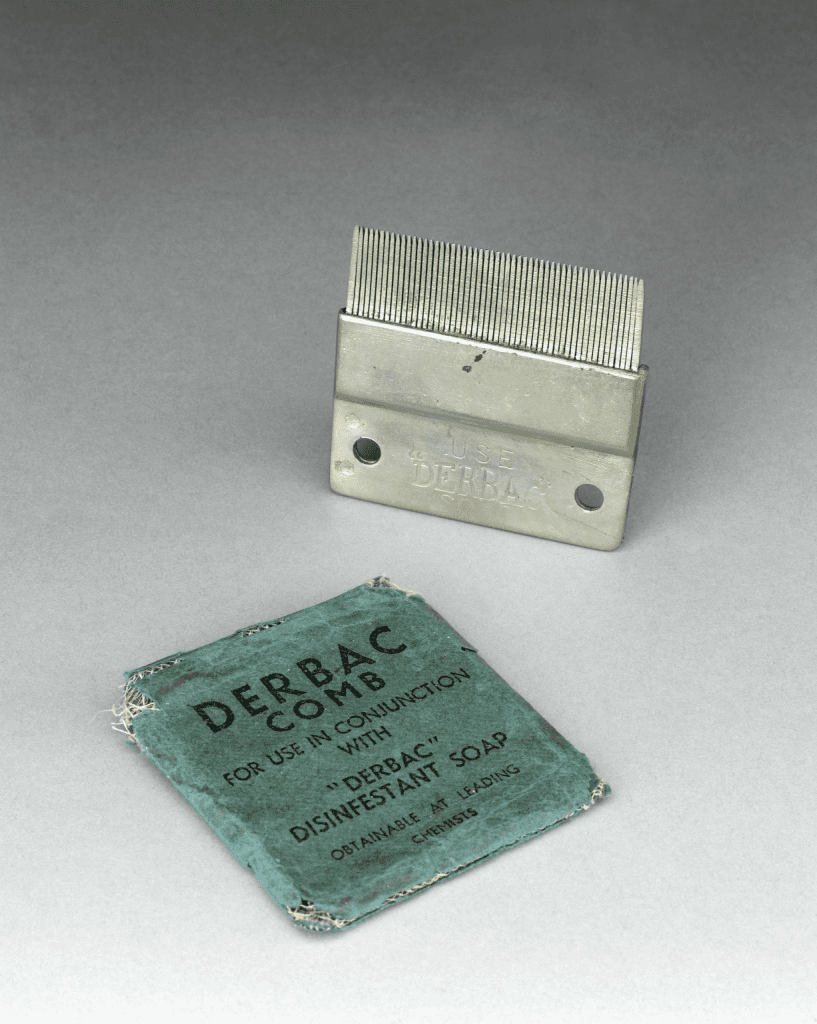Head lice have been a persistent nuisance for centuries, particularly among schoolchildren. One of the most effective tools for tackling this issue in the early 20th century was the vintage Derbac soap nit comb. Manufactured in England between 1930 and 1940, this metal lice comb came in a simple paper envelope with detailed instructions, symbolizing an era when practical solutions were prioritized in the fight against lice infestations.
Let’s delve into the history, functionality, and cultural significance of this ingenious little tool that became a household staple during its time.

A Brief History of the Derbac Soap Nit Comb
In the early 20th century, head lice were a common problem, particularly in crowded urban environments and schools. The Derbac brand became a trusted name, producing a variety of products aimed at addressing lice infestations.
The Derbac soap nit comb, crafted from durable metal, was designed to remove lice and their eggs (commonly known as nits) from human hair. Its fine-toothed design ensured it could catch even the tiniest lice and their sticky eggs, making it a must-have tool for families dealing with infestations.
How the Comb Worked
The functionality of the vintage Derbac nit comb was straightforward but highly effective. Paired with a soap treatment—often provided by the Derbac brand—the comb was used to meticulously remove lice and nits from the hair shaft. Here’s how the process typically worked:
- Step 1: Apply Soap Treatment
The hair was first washed with a specialized lice treatment soap. This soap helped loosen the grip of the lice and eggs on the hair, making them easier to comb out. - Step 2: Section the Hair
To ensure thorough removal, hair was divided into small sections. This meticulous approach helped parents or caregivers target every strand. - Step 3: Comb Carefully
The nit comb was then used to comb through each section of hair, starting at the roots and working toward the ends. The fine teeth of the comb effectively trapped the lice and their eggs, pulling them out of the hair. - Step 4: Clean the Comb
After each pass, the comb was wiped clean to ensure no lice or eggs were reintroduced into the hair.
The effectiveness of this comb lay in its simplicity. It required no electricity or complex mechanisms—just patience and persistence.
The Cultural Impact of the Nit Comb
A Household Staple
During the 1930s and 1940s, nit combs like the Derbac model were a common sight in homes across England. They represented a practical solution for a widespread problem, particularly in households with young children.
The ‘Nit Nurse’ Experience
While nit combs could be used at home, they were also an essential tool for school inspections. Children often dreaded visits from the infamous “nit nurse,” a school official tasked with checking for lice. Equipped with combs like the Derbac nit comb, nit nurses would inspect hair for signs of infestation and recommend treatment if needed.
For many, these inspections were an embarrassing rite of passage. However, they played an important role in controlling outbreaks in schools, where lice spread rapidly through shared brushes, combs, and hats.

Why Metal Nit Combs Were Revolutionary
Durability and Precision
Unlike modern plastic combs, the vintage Derbac comb was made of metal, which made it incredibly durable. Its fine teeth were perfectly spaced to catch even the smallest nits, a feature that was crucial for effective lice removal.
Reusable and Eco-Friendly
In an era before disposable products became the norm, the Derbac nit comb was designed for repeated use. With proper cleaning, a single comb could serve a family for years. This reusability made it a cost-effective and environmentally friendly option.
The Science of Lice Removal
Head lice are tiny, wingless insects that feed on human blood. They attach their eggs, or nits, to the hair shaft with a strong adhesive, making them difficult to remove. Direct contact with an infested person or sharing personal items like hats and combs are the primary ways lice spread.
The Derbac nit comb was designed to disrupt this lifecycle. By removing both the lice and their eggs, the comb helped prevent reinfestation. Regular use ensured that any remaining eggs were caught before they could hatch, effectively breaking the cycle.

The Evolution of Lice Treatments
From Manual to Chemical Solutions
In the 1930s and 1940s, mechanical methods like nit combs were the primary way to tackle lice. The process required time and effort but was effective and safe. Over the years, chemical treatments, such as medicated shampoos and sprays, became more popular. While these products offered convenience, they also introduced concerns about toxicity and resistance.
The Enduring Appeal of Nit Combs
Despite advancements in lice treatments, nit combs remain a trusted solution for many families. Their ability to physically remove lice and nits without chemicals makes them a preferred choice, especially for young children or individuals with sensitive skin.
Preserving History: The Derbac Nit Comb Today
Today, vintage nit combs like the Derbac model are sought after by collectors and history enthusiasts. They serve as a reminder of a time when ingenuity and practicality were the cornerstones of everyday life. Museums often display these combs as part of exhibits on hygiene and public health, highlighting their role in combating a common yet persistent problem.
A Legacy of Ingenuity
The vintage Derbac soap nit comb represents more than just a tool for lice removal. It embodies a bygone era when simple, effective solutions addressed everyday challenges. Its metal construction, paired with its practical design, made it a staple in homes and schools for decades.
As we look back on this humble comb, we’re reminded of the importance of resilience and resourcefulness in overcoming life’s little nuisances. Whether you remember it from personal experience or are discovering it for the first time, the Derbac nit comb is a testament to the enduring fight against head lice—one strand of hair at a time.